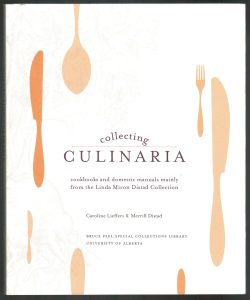What did the 19th century smell like? What was it like to stroll ankle-deep in horse effluent and live by the 25-watt glow of an oily lamp on winter evenings?
Many Canadian historians and documentary filmmakers recall the facts and figures of the past without ever providing a true tactile sense of how our ancestors got by, with one exception. We can still gain a taste of what they ate.
Collecting Culinaria is a tribute to an extraordinary trove of historic cookbooks collected by Linda Distad, a University of Alberta librarian who died in 2012. Distad had a mania for heritage recipes. Her collection ran to more than 3,000 titles including the first English-language cookbook published in Canada, The Cook Not Mad, circa 1830. Consider the recipe for corn beef: “To one hundred pounds of beef. three ounces salt peter, five pints of salt, a small quantity of molasses will improve it, but good without.”
Editors Caroline Lieffers and Merril Distad write that “the social and economic history of food, cooking and dining habits, subjects once mainly the province of anthropologists and sociologists,” are only now are taking their rightful place as archival documents.
What was it like to dine in Canada circa 1913? Here’s a menu from the cookbook Fifty-Two Sunday Dinners: consommé, beef tongue, baked potatoes, creamed celery, plum pudding – a beefy, heavy, tasteless meal for people accustomed to hard physical labour. The tongue had to be simmered in hot water for two hours just to be edible.
Collecting Culinaria celebrates them all including the famed Fannie Farmer Cookbook, first published in 1915 and “credited with popularizing level measurements,” now in its 13th edition, and the Joy Of Cooking introduced in 1931: “With its chatty and familiar tone, the text would become a bestseller and remains popular today.”
“Books might reflect wartime exigency or 1950s abundance, and many titles were little more than quick money makers for enterprising publishers,” Culinaria notes. “Indeed, while at the beginning of the century many households may have owned only one or two cookbooks, families – now less likely to have servants – were also increasingly accumulating small culinary libraries.”
Recipes date from Roman times but Culinaria credits an English homemaker, Isabella Beeton, as author of the “culinary and household management touchstone” that started the whole ball rolling in 1859. Mrs. Beeton’s Book Of Household Management ran to 1,112 pages of recipes, cleaning tips and advice.
When she died in 1865 – she was only 28 – her widowed husband sold the rights to Ward & Lock Publishing and the rest is history. Variations are still in print. “Throughout its many iterations,” Culinaria writes, “the trademark ‘Mrs. Beeton’ has assumed an almost mythological status, representing both the practicality and excess of British cookery over the last hundred and fifty years.”
Collecting Culinaria is spectacularly illustrated with photos and artwork. It will make you want to hunt up an old recipe for corn beef or beef tongue, and get cooking.
By Holly Doan
Collecting Culinaria, by Caroline Lieffers & Merrill Distad; University of Alberta Press; ISBN 9781-55195-3243






